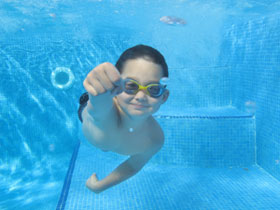how much chlorine to add to pool
| |
Proper Chlorine Levels for A Healthy Pool
Keeping the water clean, pathogen-free, and sanitary is key to getting the most enjoyment out of your swimming pool. But this undertaking isn't as simple as tossing in a few pool chemicals and calling it a day. Adding the right amount of chlorine is sometimes a tough balancing act, but it is absolutely necessary to maintaining a healthy pool.
First off, if a lot of organic materials have built up in the pool, normal doses of chlorine is not going to resolve the problem. You will have to shock the water, which involves adding heavy amounts of chlorine for a short amount of time to fully destroy all bacteria and organic matter in the pool. If it has been a while since the pool has been shocked or it was just filled, shock it first so that the chlorine can do its job. Keep in mind that you should wait at least 8 hours before going into the pool after using a chlorine-based shock. To maintain a good healthy pool, pool owners should shock their pool once every 1-2 weeks.
 Next, the pH level of the water needs to be measured. If the pH level is too high, even having the right level of chlorine won't be enough to make sure the water is safe to swim in. Chlorine loses its effectiveness in acidic water. Shoot for a pH that is the same as human tears--around 7.2 but up to 7.6. If the pH is too high, it is time to add some muriatic acid in the deep end of the pool while the pump is running. This will quickly circulate the compound, and you can retest it in about six hours. Don't try to lower the level too quickly or the levels will fluctuate, causing you frustration.
Next, the pH level of the water needs to be measured. If the pH level is too high, even having the right level of chlorine won't be enough to make sure the water is safe to swim in. Chlorine loses its effectiveness in acidic water. Shoot for a pH that is the same as human tears--around 7.2 but up to 7.6. If the pH is too high, it is time to add some muriatic acid in the deep end of the pool while the pump is running. This will quickly circulate the compound, and you can retest it in about six hours. Don't try to lower the level too quickly or the levels will fluctuate, causing you frustration.
Now that the water is ready, start adding the chlorine. Pool chlorine is sold as tablets or sticks that can be placed into floating or automatic feeders. Try to avoid those that require water running over them to dissolve, as you will be tempted to place it in the skimmer basket. This will introduce very low pH water into your pumping system and cause it to prematurely fail.
Also avoid tablets that crumble and fall apart. Good quality tablets will dissolve at a more or less even rate, and will simply get smaller over time while keeping their shape. This is especially important if a floating chlorinator is going to be used.
Automatic chlorine feeders are very popular with pool owners because of their ease of use and the help they provide in properly maintaining a swimming pool. Chemical feeders will meter out precise amounts into the pool automatically, while allowing the pool owner a means of precise control over the amounts that are dumped into the swimming pool.
Regardless of how frequently or what system you use to add chlorine to the water, the chlorine level should stay between 1.0 and 3.0 parts per million (ppm) to maintain a healthy pool. Anything higher will make you to run the risk of red eyes and swimmers itch. There should be at the most a slight smell of chlorine even at the highest levels. If there is a strong smell, that is a sign that you need to shock the pool and remove built up contaminants.
Calculating how much chlorine to use will involve some math but nothing too complicated. The hardest part is determining the total gallons in the pool. Luckily, many pool supply houses provide online calculators to help, such as the one at http://www.havuz.org/pool-calculators.htm.
Once you know total volume, then it's a simple formula: one ounce of chlorine will give you a 1 ppm in 75,000 gallons of water, or 0.013 ounces of chlorine per 100 gallons.
But, what is most important is consistency. Make sure to check the pH levels every two to three days as the pH level will affect how well the chlorine sanitizes the pool. And, keep in mind that the chlorine is neutralized when it interacts with any contaminant and by sunlight. If the proper levels of chlorine are not being maintained with a floating device that uses one-inch tablets, you may need to go with three-inch tablets or adjust the chlorine feeder if you have an automatic system. Stay consistent with testing of pool water, and any changes can be quickly caught and corrected.
Read Next: Protect your Family from Chlorine in Bath & Shower Water
| |
how much chlorine to add to pool
Source: https://www.freedrinkingwater.com/water-education3/proper-chlorine-levels-for-a-healthy-pool.htm
Posted by: dietzcorescoleat.blogspot.com

0 Response to "how much chlorine to add to pool"
Post a Comment